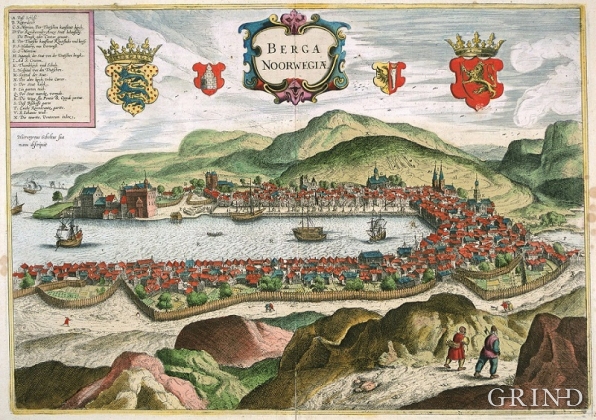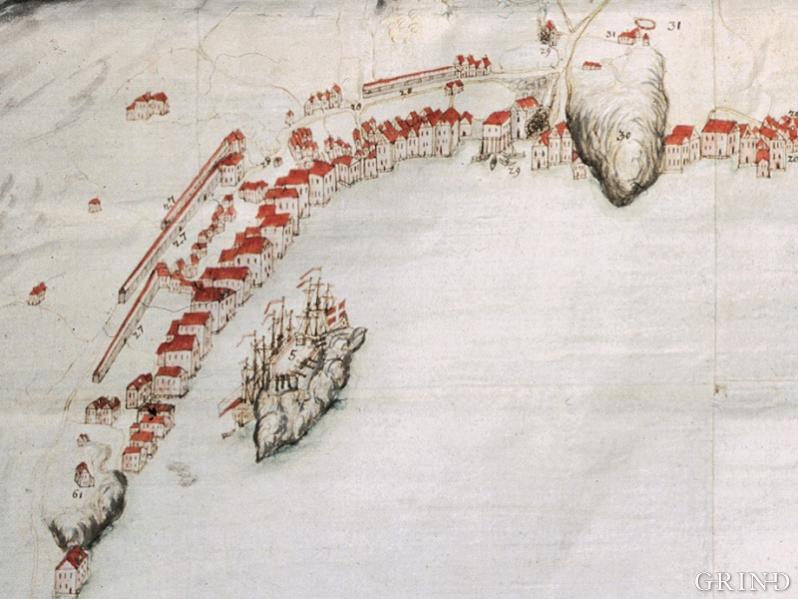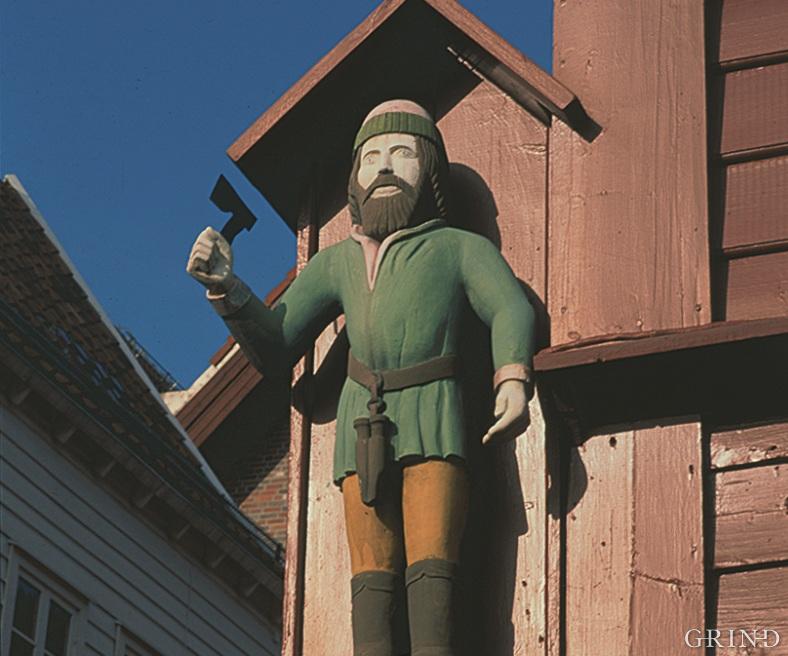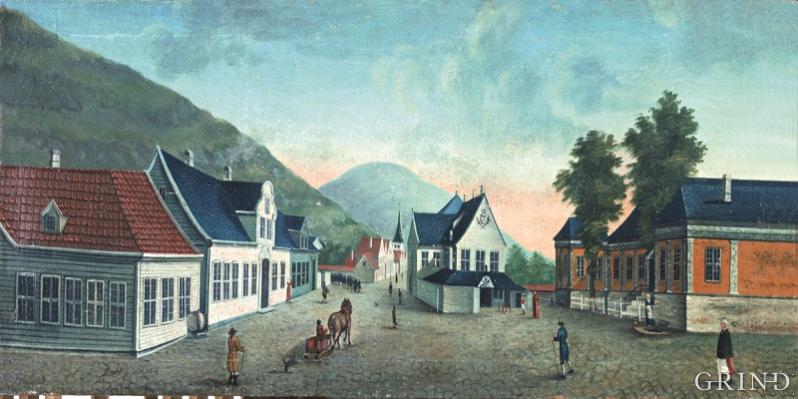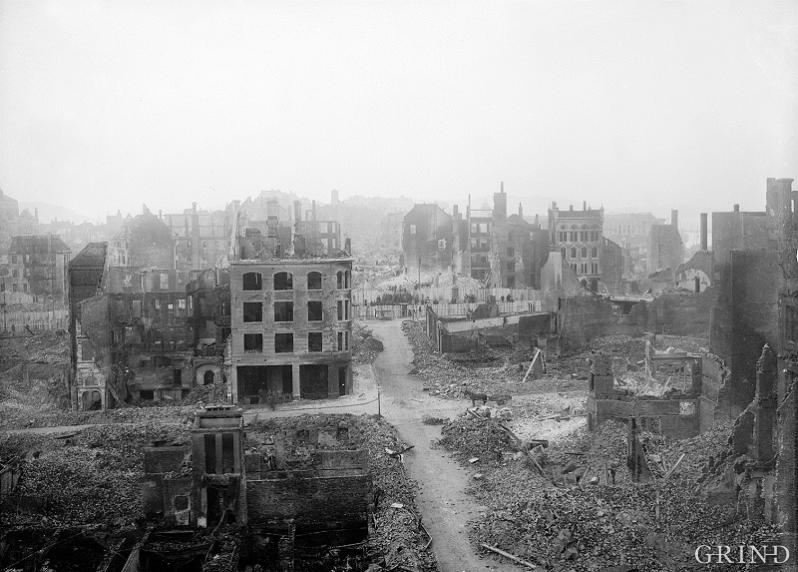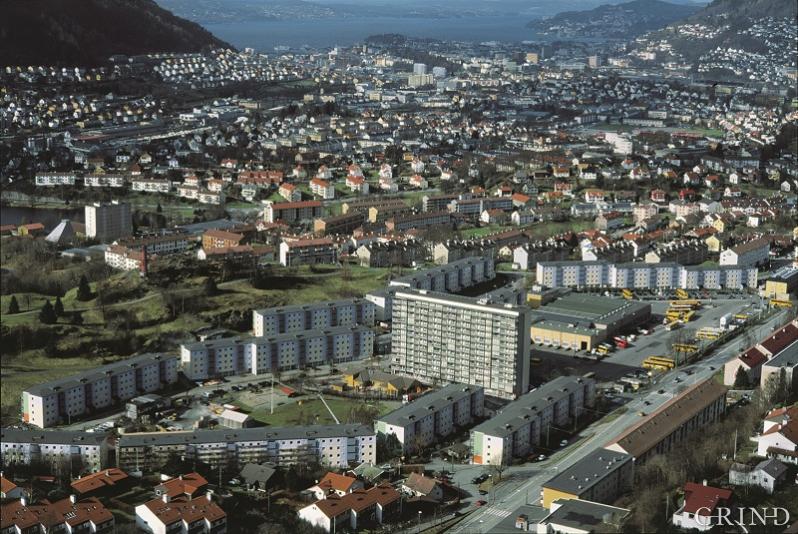Published: 19.05.2009 | Author: Per Jahn Lavik
Hieronimus Scholaeus’ prospect of Bergen was painted about 1580 and published in Cologne in 1588 in a large atlas with pictures of “cities from the whole world” (Civitates orbis terrarum. The edition which is presented here was published in Amsterdam in 1657. Although the picture of the city is the same as on prospect from 1580, the original Hanseatic cargo ships are replaced with more up to date Dutch fløytskip, a flat-bottomed, three-masted trading vessel with an ample hull. The low houses portrayed here with the red roofs would mostly have had turf roofs. (photo: Svein Skare, owner: Universitetsmuseet i Bergen (B 1332)).
Bergen - our first royal residence city – has for centuries been Norway’s, and for long periods, Scandinavia’s biggest city. The historical monuments round the Vågen bay tell us that the city has been of national, historical significance. In the well-known view of Bergen from the 1580s by Hieronimus Scholeus we can recognise Håkonhallen’s characteristic stepped gables and feudal lord Erik Rosenkrantz’ proud building from the 1560s; what we today call the Rosenkrantz Tower. That is not so strange, because both buildings have been restored with that engraving as a model. Erik Rosenkrantz built together Magnus Lagabøtes castle gatehouse from the 13th century and captain Jørgen Hanssøns defence works into a powerful defence tower – a “donjon” – and equipped it with a Renaissance façade looking out over the city. Behind today’s construction at Bergenshus we can make out the contours of the medieval royal estate at Holmen, which at that time was linked to the mainland by a low, marshy neck of land.
The mediveal city
As a trade centre for the fisheries trade between the rich fishing grounds in the north and the markets further south in Europe, Bergen must have received city status in the 11th century, probably under Olav Kyrre. In the course of the 12th century the significance of the city grew rapidly, and under the period of rule of Håkon Håkonsson (1217-1263) Bergen was an important city in northern Europe. It was then that Norwegian power was at its greatest extent.
The urban settlement developed at first on the east side of the Vågen bay. Gradually the edge of the Quay was pushed out into the Vågen bay with every rebuilding which occurred after the innumerable fires. Today we cannot be sure whether the building started out at Holmen or in Vågsbotn. Trading activity in Vågsbotn seems to have stagnated in the course of the 13th century, at the same time as the church of St. Olav went over to become a monastery church for the Franciscans or the Grey Brothers.
On the Strand or Strandsiden on the west side of Vågen bay reference is made in the 12th century to Jons Monastery which was situated at the present Tårnplass, and Munkeliv monastery with the church of St.Michael, in the area that we today call Klosteret (the Monastery).
In the middle of the 13th century the Archbishop of Nidaros raised his impressive town property in stone where the New Church (Nykirken) now lies, right opposite the royal building at Holmen, on the other side of the bay and with a façade longer than that of Håkonshallen. The property contained a storehouse for tithe incomes. The monasteries would also have needed buildings by the sea. Besides in the 13th century we know that several members of the aristocracy had their own properties on Stranden. In the course of the 13th century there is reason to believe that maritime buildings surrounded the whole of the Vågen bay. We still know too little about the building development along Strandsiden. In recent times it has had a similar structure to that of Bryggens properties - with one essential difference. On Bryggen there developed a continuous wharf in front of the properties. On Strandsiden and on Vågsbunnen on the other hand the booths were built out into the sea with “hops” i.e. the sea area between two piers where the boats went in to load and unload, right up until the major fire in 1916.
Little is known about the ordinary citizen’s houses. Both two and three storey houses with hearths are recorded from Bryggen, as well as simple half-timbered and log houses of the loft type. Wealthy city folk’s houses can have been like Finnesloftet in Voss and Lagmannstova in Aga which perhaps served as models for the urban environment.
Reformation and renaissance
Bergen’s position as the centre of Norway’s might was gradually weakened, but it retained its position as Norway’s largest city for a long time. When Håkon V.Magnusson took over the throne in 1299 on the death of his brother Erik he remained in his newly constructed castle “in Akersneset” on the Oslo Fjord from which he had earlier ruled his duchy. After Håkon VI’s death in 1380 there was no longer a royal residence at Holmen in Bergen. The great sickness in 1349-50, the Black Death, destroyed the population base and reduced the West Norwegian aristocracy which had played a key role in Norwegian foreign trade.
The German “winter dwellers”, the Hansa folk, who had begun to make their mark in the 13th century, eventually filled the vacuum, and soon trade with Bryggen with the north of Norway and foreign trade was in the hands of the Hansa folk. A distant royal power in Copenhagen and a king’s commissioner or palace commissioner at Bergenshus were long on a losing wicket. During the wars with the Hansa towns, Bergen was sacked and set on fire on three occasions by the Hanseatic freebooters, the Vitaline Brothers . In 1476 Bryggen and parts of the eastern side of the city as far as the Grey Brother monastery (the present cathedral) were burnt, and in 1487 the whole of Strandsiden from Klosteret to Skostredet was burnt.
While the Hansa folk on Bryggen kept the old property community which suited their organisation, it was gradually abandoned from the middle of the 16th century in Øvregaten and Strandsiden. The new individual properties had still the characteristics of a property in the Bergen meaning of the word, gård with large sea houses facing the Vågen bay and dwelling houses on the street behind with small stores in semi-underground cellars. The so-called fire-proof cellars above ground were always an important part of the shop-keepers’ “insurance arrangements”.
When Strandgaten’s outer part was burnt after the last war, it was the row of vaulted cellar buildings which made the greatest impression. In about the same way they can also be seen on the perspective map prepared after the fire in 1686. After this fire Nyalmenning - the existing Holbergsalmenning – was constructed.
The Scholaeus engraving from the 1580s shows a city tightly concentrated around the Vågen bay, with the new Renaissance palace furthest out on Holmen. The great expansion throughout the 17th century broke down the boundaries off the Vågen. Wharf sheds of the same type as on Strandsiden came up along Skuteviksbukten and Sandviksbukten and along Pudde Fjord at Nøstet and Sydnes. Many of the wharf sheds which are still standing in Sandviken and Skuteviken date back to the 17th century. We can see this from the heavy timber, the wooden jointing technique from the Middle Ages and the painted acanthus tendrils which are part of the decorative repertoire of the Renaissance and Baroque styles in Europe. The seahouses (large storage halls) created workplaces, and others followed: ropeworks and mills. The watercourse down the hillside in Sandviken brought power to the mills and freshwater to the clusters of houses which grew up here. At Sydnes, Nøstet and the west side of Nordnes Peninsula it was common for seamen and fishermen to settle.
“The old city”
On the 19th May 1702 Bergen was struck by the most extensive of a long series of city fires. The fire started just beside Manufakturhuset and took buildings on both sides of the Vågen bay - so that the Maria Church, the fortress and the buildings from Kroken up Stølen were left standing on the east side. But on Strandsiden the Nyalmenning stood the test as a fire break. This time Bryggen or Kontoret were consumed - the part of town which had not been burnt in its entirety since 1476 and had this preserved its medieval character. But in the reconstruction a decisive break with the past was not made. Functions and needs were the same, and the site conditions were the old ones.
Preserved buildings from Bryggen and in Vågsbunnen show that the log houses from the reconstruction period had stood with unpanelled, painted timber walls – at Bryggen the gables were even decorated with painted acanthus tendrils. The houses in Bryggen were weatherboarded in the 1730s, at the same time as the leaded windows were replaced with windows with wooden frames.
After the fire in 1756 new stylistic impulses made themselves felt on the city scene. The Rococo style must have suited the temperament of the Bergen folk well and the city’s irregular topography. During the reconstruction after the fire of 1702 complaints were made that the citizens “do not observe lines, regularity, orderliness or comfort”. The Rococo style came to characterise what we understand as the Old Bergen, even although details such as portals and mouldings changed with the changing styles. In 1800 the New Church and the area around it were burned, and in 1830 the area on both sides of Strandgaten between Holbergsalmenning and Muralmenning. But otherwise the main elements of the 18th century city remained unchanged through most of the 19th century.
A special feature of Bergen, compared with other Norwegian towns was the relative social equality in the city. The important citizens certainly built themselves fine, ornate houses along the main streets and common areas. But we do not find the great mansions of Trondheim or Christiania. On the other hand we find decorative and solid carpentry in the smaller houses of the minor citizenry, even in the seafarers’ and craft journeymen’s cabins at Nøstet and Verftet. A new house could easily pop up overnight, because folk from Osterøy had developed their own prefabricated house techniques. The houses were constructed at home - or on one of the city’s commons areas - taken down, and then re-erected on one of the tight sites in the city.
Most of the old middle-class wooden buildings have gone, vanished in fires and in redevelopments, because they were situated on the city’s main streets or common lands. Thus it is the recreational districts on the edge of the city area today which are the best testimony to this architecture. As early as the end of the 17th century tradespeople arranged so-called holiday rooms in the wharf sheds in Skuteviken and Sandviken. At the same time newly ennobled noblefolk established themselves with residences on the old estates outside the city as at Stend and Landås.
But above all it was Sandviken which was the part of the city for holiday houses. The Christinegård house is a fine representative for classicism, with its balustrade and its side wings, from a reconstruction around 1830. On the slope above stands the “Mon Plaisir” garden pavilion, built as a Greek temple – a piece of bric-a-brac in the landscape. With the late Empire period in the 1840s the main houses themselves also got a temple façade. The most monumental of these is Kronstad House in Årstad parish. It has been attributed to the city engineer Ole P. Riis Høegh In any event Høegh also has responsibility for some public buildings in brick from that time. Those which remain are the Bank of Norway on Vågsalmenning and the Cathedral School in Kong Oscarsgate, on the site of the old bishop’s palace.
Towards a new period
Many factors contributed from the middle of the 19th century to breaking down the old framework. New technology led to new types of business and to new forms of transport. Industrialisation began in the 1840s and Prahl’s iron foundry in Marken – at the same time as Peter Jebsen established the textile industry in Arna. In 1850 Wiingaard’s iron foundry in Årstad county came along – it was combined with Prahl’s foundry in 1855. In 1851 a bridge was built over the Strømmen river and in 1855 Michael Krohn established the Bergen Mechanical Workshops in Solheimsviken. In the same year Laxevaag Shipyard was also established as a further development of an older ship-building tradition. In both Solheimsviken and Laxevåg urban development grew up - small, traditional wooden houses, but also bigger workers housing.
But it was the northern part of Fjellsiden - the areas at Stølen - which came to be the workers’ city. “The Society for the Building of Workers’ Houses in Bergen” was established in 1852 and built immediately afterwards the so-called House in 35 Henrik Wergelandsgate, which was made subject of a preservation order in 1982. This was a barrack-like two storey wooden building with small two room flats of 28 square metres each and for 48 families. This type of building did not yet come to provide a model for further building. The adjacent areas, Krohnengen and Wesselengen were planned in the 1860s for a tight-knit development of small houses, laid out in blocks, in fact a standardised, standard house development, but with its roots in the older Bergen wooden house environment. It is and was a pleasant area. But one of the reasons for it being zoned as a workers’ area was that it was located too high to be served from the city’s waterworks. And this area soon came to be overpopulated to a degree that had never been planned for.
The city grows
The city’s boundaries gradually began to feel tight-fitting. Even the areas for new development at Nygård were located outside the city boundaries. Together with Møhlenpris, Lungegården and Kalfaret, they made up the Cathedral’s country parish . These were areas which had originally belonged to the city’s common area but which had been privatised during the 16th and 17th centuries. In 1875 the Storting (Norwegian Parliament) eventually approved the incorporation of the country parishes which were established with their own executive committees. During the 1880s and the 1890s the development of these areas got real speed up. Now a completely new house type emerged – the Continental European apartment building in brick, with neo-Renaissance facades with stucco work in cement. In Norway it is only Oslo and Bergen which have this type. Buildings for the upper social classes with big, and for these times, well equipped apartments were put up at Sukkerhusengen and partly on Møhlenpris; at Ladegården and lower Nygård denser, darker and more cramped apartments were put up for the working classes. On the other hand: many “awful square boxes without a trace of architecture or style” were put up along the Nygårdsgaten. Highest up on the old “Rakkerhaugen” the Christiania architect Nebelong put up in 1864 “the new” museum building in Italian influenced Neo-Renaissance style.
The heights at Nygård were literally a model for a socially divided society. On the upper slopes blocks of brick-clad two storey wooden houses for the middle classes, up on the top first were some bigger brick apartment blocks in a luxury edition, and then English influenced terraces in brick with front gardens towards Parkveien and the new Nygårds Park, and finally along the east side of Parkveien and Villaveien and towards Sydnes and Museum Squares were the great resplendent villas in wood and brick for the truly wealthy.
In the meantime the historic city core was beginning to change. For the first time, from the 1870s onwards, houses were demolished which had not been damaged in a fire; now to build bigger houses in brick. It was the beginning of a new Continental “city architecture”. German inspired through the period’s German educated architects.
It was the newest and most classically influenced city district, the site of the fire from 1855 which was first transformed in the variegated image of historicism. In the course of the 1880s Torvalmenning and adjoining parts of Strandgaten were transformed to become a modern, Continental city district. Most of this disappeared in the major city fire in 1916, and as a result of disparagement in later times.
Not even the homogeneous historical image around the Vågen Bay was to survive the century. In 1901 the properties on the sea between Muralmenning and Holbergsalmenning were burnt down. As in the past the area was rebuilt fairly quickly, but now in brick and with completely different dimensions. The stylistic influence is the new style of the period – Jugend or Art Nouveau. It is rare in its pure form in Bergen which otherwise had little building activity during this time. But the really radical thing which happened was that a new street was built – C.Sundtsgate – between the wharf sheds and the development on the down side of Strandgaten. Now it was no more radical than it had been proposed after every new fire since the 17th century. Thus continuity was interrupted on Strandsiden.
And the growth of the city continued. In 1915 the independent municipality Årstad was incorporated into Bergen. This merely strengthened the urbanisation process which had been underway for a long time.
The Bergen fire
The decisive divide for the old city took place on a stormy January day in 1916; which from then on was known as the Bergen Fire. It naturally takes its place in the series of historical city fires – and also its origins. An apprentice is working with an exposed flame in southern Muregård. In the course of a short time not only the property but the whole of Strandsiden between Muralmenning and Torvalmenning/Rådstuplass is a roaring inferno. Gone are the traditional wharf sheds along the Vågen bay and the proud city architecture from the turn of the century.
Despite difficult times there was an impressive desire and ability to organise the work to clear up and reconstruct. A Scandinavian planning competition was held as well as several building competitions with sizeable ambitions both functionally and aesthetically. They looked and they regretted the breach with the historical continuity and sought after inspiration in the local architecture from the 17th and 18th centuries. A new neo-Baroque so to speak. And the town planning ideals were neo-Baroque, perhaps with a whiff of Rococo, in the sense of squint axes and surprising perspectives.
War and reconstruction
The war years 1940 to 1945 brought with them dramatic, new changes to the city scene. In 1940 large parts of the old wooden house development on Nordnes between the Vågen bay and Haugeveien were destroyed by English bombing raids. However the greatest destruction took place in the year 1944. Laksevåg where the Germans had their submarine bunker got it worst, but the Engen, Nøstet area also suffered where the old theatre, Europe’s oldest civil theatre was completely destroyed.
The greatest damage, however, was due to an explosive catastrophe took place on 20th April 1944 when a German ammunition boat exploded at the Fortress Quay. The damage was extensive over large parts of the city area, but it was worst in the outer part of the Vågen bay. Central historical monuments such as Bergenshus Fortress with Håkonshall and the Rosenkrantz Tower on the one side and the New Church and the Tolbooth on the other were laid in ruins.
Of course it was a national duty to rebuild these buildings, especially Bergenshus. But for other parts of our building heritage there was however little understanding, both in the war years and the 20 post war years. Clearance and reconstruction were complementary.
After persistent work by the Historical Monuments Society there was success in the course of the 1960s in getting authority for the preservation of the Outer Markvei district and the part that remained of Strandgaten, between Holbergalmenning and Muralmenning.
The time of reckoning for the demolition ideology came in 1974 when the City Council lifted the clearance resolution for Marken which was now largely zoned as a preservation area. This illustrates a dilemma in post-war urban development; on the one side was the desire for the planning of the city’s central areas; on the other side there was the movement away from the city centre towards the new residential areas.
The boundaries are breached
The period after the war is characterised precisely by these new residential areas beyond the ring of villa districts which surrounded the high density development in the old city.
In the Landås district in the southern part of the city, a completely new “satellite town”, the same size as a medium sized Norwegian town, grew up in the course of a few years. This satellite town development literally reached its climax on the municipal boundaries in a concentrated high-rise development, Mannsverk at Fana, Lønborg at Åsane and the point blocks in Mikael Krohnsgate on the boundary with Laksevåg Municipality.
Fyllingsdalen was incorporated into Bergen in 1955, but the development did not get underway until 1960, with the Varden area furthest south in connection with the development of the main naval base at Haakonsvern in Mathopen. At that time the housing cooperatives expansion was also underway in the neighbouring municipalities with Søre Slettebakken in Fana, and Prestestien in Åsane, both of them high density. Nor did it go any better in Loddefjord in Laksevåg Municipality.
The incorporation of the neighbouring municipalities of Arna, Fana, Laksevåg and Åsane in 1972 did not lead to any radical change in the pattern of housing construction. Åsane continued to predominate. Proximity to Flesland Airport and the new motorway from the south was decisive in the siting of the business areas at Kokstad and Sandli which provided space for most of the new oil-based activity.
The new urban structure put enormous pressure on lines of communication and thus on the old city centre. This tendency was reinforced by difficult topography and by the fact that rail-based local transport facilities, both tramway and railway, were closed down.
The Eidsvåg Tunnel to Åsane and the Puddefjord Bridge to Laksevåg, both of them built in 1956 - were decisive breakthroughs for the growth of the city. The tunnel through Løvstakken to Fyllingsdalen came first in 1968. The railway tunnel through Ulriken in 1964 closed the local line to Fana but created a better and more rapid line to Arna. The new northern inward traffic lane from Sandviken to Nygårdstangen thus far managed to contain the pressure from the forced development in Åsane and Nordhordland. A new road connection to Haukeland, to relieve the existing road over Kalfaret, will be able to demolish what is left of Alrekstads royal estate. Thus we are back where we began – literally at the end of the road.
- Bjerknes, K. (1961) Gamle borgerhus i Bergen. Bergen, Universitetsforlaget.
- Koren-Wiberg, C. (1908) Bidrag til Bergens kulturhistorie. Det Hanseatiske Museums skrifter, nr. 2. Bergen, Museet.
- Koren-Wiberg, C. (1921) Bergensk kulturhistorie. Det Hanseatiske Museums skrifter, nr. 3. Bergen, Museet.
- Lavik, P. J. (1976) Hus og byggeskikk. Hartvedt, G. H. red. Hordaland og Bergen. Bygd og by i Norge. Oslo, Gyldendal, s. 447-473.
- Lidén, H.-E. & Magerøy, E. M. (1980-1990) Bergen. Norges kirker. Oslo, Riksantikvaren.
- Trumpy, B. (1977) Bergenske lyststeder. Bergen, Foreningen til norske fortidsminnesmerkers bevaring. Bergensavdelingen.
- Det Antikvariske register for Bergen (1968-1985). Bergen, Foreningen til norske fortidsminnesmerkers bevaring. Bergensavdelingen.

